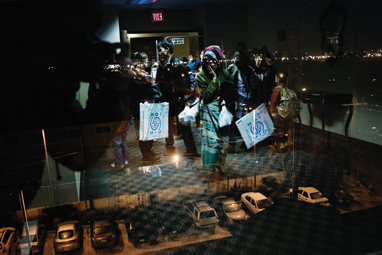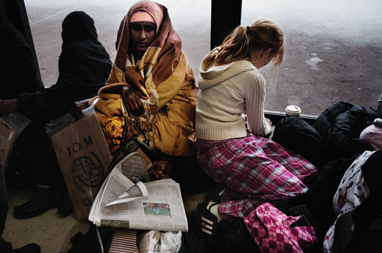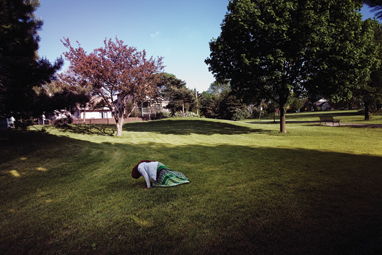For our annual photo issue, Gabriele Stabile presented a selection from his long-running project documenting the initial experiences of refugees arriving in the United States. With the help of the International Organization for Migration, Stabile was able to photograph the first experiences of many refugees in the transition motels they are housed in while they await placement somewhere in the US. Up above, watch the slideshow, featuring an extended cut of the photos narrated by Stabile, and after the jump read T. Cole Rachel's feature on Stabile's photo work at the refugee motels.
It’s impossible to know what these people might be thinking, but their feelings—a convergence of hope, anxiety, and often, complete dismay—read very clearly. Gabriele Stabile's photos were taken at what he refers to simply as “refugee motels”—temporary accommodations set up to house incoming political refugees and their families as they enter the United States for the first time. Refugees from West Africa, Latin America, Eastern Europe, and the Middle East will spend their first twelve to fifteen hours on US soil at a hotel (generally of the budget variety, located nearest the airport) before they are ultimately sent to whichever far-flung location in the US deemed best-suited to their specific ethnic or religious group. Typically, they will be placed with a sponsor family of a similar background, but often the final destination is still jarringly incongruous (non-English speaking refugees from Africa going to live in Mobile, Alabama or the rural Midwest, for example). For the arriving refugees, these hotels offer their first window into what is often a bewilderingly unfamiliar world.

For Italian-born Stabile, the concept of photographing the refugees quickly evolved from being simply aesthetically interesting to something deeply personal. “As someone who has moved around a lot during my own life, I was interested in documenting people in a state of transition,” he says. “I didn’t want to exploit the situation in any way or add discomfort or confusion. Still, I didn’t expect the experience to be so emotional, or that I’d get so involved. Sometimes the people seemed to think that I was part of the deal, like I had been hired to help them and to take their pictures.” The help Stabile provided often ranged from the mundane—explaining the concept of air conditioning or how to use the hot/cold running water—to the intimate. “People would often ask to use my cell phone or have me help them contact their relatives back home,” he recalls. “They had no way to let their families know that they had made it to the States, that they were okay. It’s hard to say no to a request like that.”

With the help of the International Organization for Migration, the organization responsible for transporting and placing the refugees, in early 2007 Stabile was allowed to take photographs at all three major points of entry (Miami, Los Angeles, New York), interacting with refugees from all points on the globe. “You have only about ten hours to spend with people before they leave the motel,” he says. “Most people are too anxious or too excited to sleep. In fact, most of the people end up sitting outside in the halls or on the floor, rather than on the furniture. You realize that everyone has left some kind of terrible situation behind. The old people have a sadness, often just now realizing that they will probably never go home again, that they will die in this strange foreign place. The parents are desperate to keep all of the children together. Everyone seems to be in shock. Even though ten or twelve hours doesn’t seem like a long amount of time, for these people it often seems like eternity. Time kind of stops.”

It’s hard to imagine a temporary purgatory more quintessentially American than a chain motel. For the itinerant visitors, it’s a place full of vending machines you can’t use, telephones you don’t know how to operate, and televisions full of loud, incomprehensible imagery that is, in all likelihood, in direct opposition to your traditional beliefs in every way possible. For many refugees, their first American meal will come from a Burger King and their first night will be spent in a place specifically engineered to be universally bland. Still, as Stabile’s photographs show, the hotel can be a place of wonder. For the visitors, it’s a kind of static environment, which has nothing whatsoever to do with what came before or what might happen next. Despite the troubling context in which they are photographed, Stabile’s images are concerned not only with the strange juxtaposition of cultures and the universal feeling of foreignness, but also with the human capacity to adapt. They illustrate the resilience of cultural identity and religious beliefs, no matter the situation.
“One of the biggest surprises for me when I am shooting these photos is just how eager the people are,” says Stabile. “Even though they must be exhausted and they finally have the opportunity to rest for a few hours, often the entire family will sit near the doors with their bags packed. They worry that no one will come for them. More than anything, they are still terrified of being left behind.”